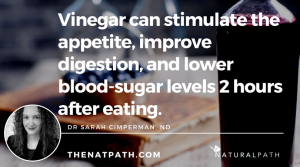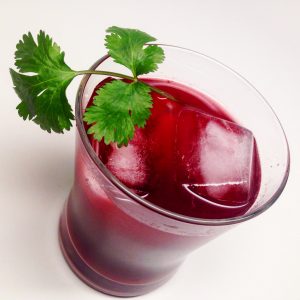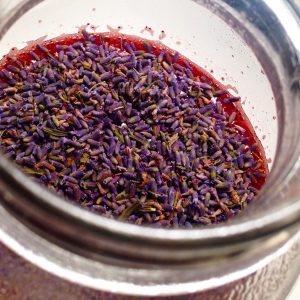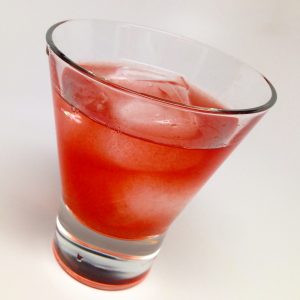Shrubs are a refreshing combination of sour and sweet
 Also known as drinking vinegars, these beverages date back centuries. They are traditionally made with vinegar, fruit, spices, and sugar. Shrubs likely started as a way to preserve summer harvest but they have medicinal benefits as well.
Also known as drinking vinegars, these beverages date back centuries. They are traditionally made with vinegar, fruit, spices, and sugar. Shrubs likely started as a way to preserve summer harvest but they have medicinal benefits as well.
When taken before meals, the vinegar in shrubs can stimulate the appetite, improve digestion, and lower blood-sugar levels 2 hours after eating.1 Raw and unpasteurized vinegars are also a good source of probiotics, the beneficial bacteria that are essential for good health. These friendly bacteria protect us from disease-causing bacteria and they break down environmental toxins, manufacture essential nutrients like vitamins and short chain fatty acids, modulate the immune system, help regulate inflammation, influence the production of neurotransmitters like serotonin, and play an important role in appetite, satiety, fat accumulation, and energy usage.
Fruits Added to Shrubs
Fruits added to shrubs can be good sources of antioxidants and many have other benefits as well. For example, citrus peels contain limonene which has been shown to have anti-inflammatory,2 anti-stress,2 and anti-cancer3 activities in the body. Raspberries are an excellent source of ellagic acid, a compound also shown to have anti-inflammatory and anti-cancer actions.4 Furthermore, ellagic acid has been studied for its effects on the skin and shown to protect against wrinkles by preventing the destruction of collagen and inflammation associated with UV-B radiation from the sun.5
Spice it up
Spices add flavor but they can also have positive effects on our health. Cinnamon,6 ginger,7 and cayenne6 have been shown to reduce inflammation, lower fasting blood sugar and insulin levels, and improve blood sugar control. Lavender has been shown to reduce anxiety and depression and lower blood pressure and heart rate.8
Shrubs are traditionally made with sugar but I sweeten them with honey instead. Honey provides a homeopathic-like dose of local plants which can minimize environmental allergies. It also acts as a demulcent, coating and soothing sore throats. One study9 found that honey reduced levels of C-reactive protein (an inflammatory marker in the blood), decreased levels of homocysteine (an amino acid in the blood associated with cardiovascular disease), and had positive benefits on cholesterol markers by increasing HDL cholesterol and decreasing total cholesterol, LDL cholesterol, and triglycerides.
Recipes for Shrubs
Recipes for shrubs can be made from an almost endless combination of vinegars, fruits, and spices. I used red wine vinegar but apple cider vinegar, coconut vinegar, or champagne vinegar would also be good choices. Instead of raspberries, you could use cranberries, strawberries, black berries, blueberries, pomegranate, peaches, pears, melon, mango, or rhubarb. Instead of lavender, you could use citrus peel, a cinnamon stick, ginger, star anise, cardamom, cloves, fennel seeds, or vanilla bean. For a spicy shrub, add Szechuan peppercorns or dried chili pepper. For an herbal shrub, add tarragon, lemon balm, lemon verbena, basil, bay leaves, or even rosemary.
Shrubs are Very Versatile
 Shrubs are a very versatile beverage. They can be mixed with flat or sparkling water for a healthy soft drink, usually one part shrub to 4 or 5 parts water. They can also be mixed with unsweetened black or green tea for a refreshing summer drink. You can stir them into unsweetened fruit juice for a non-alcoholic mocktail. Shrubs can be used as an alternative to bitters in cocktails or mixed into drinks made with sparkling wine or spirits like vodka, rum, or bourbon. One example of a cocktail recipe could contain one part shrub, one part spirit, and 2 or 3 parts sparkling water or juice.
Shrubs are a very versatile beverage. They can be mixed with flat or sparkling water for a healthy soft drink, usually one part shrub to 4 or 5 parts water. They can also be mixed with unsweetened black or green tea for a refreshing summer drink. You can stir them into unsweetened fruit juice for a non-alcoholic mocktail. Shrubs can be used as an alternative to bitters in cocktails or mixed into drinks made with sparkling wine or spirits like vodka, rum, or bourbon. One example of a cocktail recipe could contain one part shrub, one part spirit, and 2 or 3 parts sparkling water or juice.
Raspberry Lavender Shrub
 I like to drink this shrub with sparkling water and garnish with a wedge of lime. If you plan to mix it with juice, it goes particularly well with cranberry juice. For a cocktail, you could also add a splash of vodka.
I like to drink this shrub with sparkling water and garnish with a wedge of lime. If you plan to mix it with juice, it goes particularly well with cranberry juice. For a cocktail, you could also add a splash of vodka.
Ingredients:
2 cups red wine vinegar
12 ounces frozen raspberries
2 tablespoons dried lavender flowers
1 cup honey
Directions:
- Add the honey and frozen raspberries to a clean glass jar and allow them to thaw to room temperature.
- Once the berries have thawed, add the vinegar. Mash and stir the mixture until the honey is fully incorporated, then stir in the lavender flowers.
- Cover and set the mixture aside in a dark, cool spot at room temperature for 2 days. Stir or shake occasionally.
- Transfer the shrub to the fridge for a week or more, until it develops a flavor you like. The tangy flavor from the vinegar should mellow and the shrub should develop a fruity aroma.
- When you are satisfied with the flavor, strain and discard the solids. Transfer the liquid to a clean glass bottle with an air-tight cover. Label with the date and contents and store in the fridge for up to 1 year.


References
1 Johnston CS, Steplewska I, Long CA, Harris LN, and Ryals RH. Examination of the antiglycemic properties of vinegar in healthy adults. Annals of Nutrition and Metabolism. 2010:56(1):74–79.
2 d’Alessio PA, Bisson JF, and Béné MC. Anti-stress effects of d-limonene and its metabolite perillyl alcohol. Rejuvenation Research. 2014:17(2):145-9.
3 Yang C, Chen H, Chen H, Zhong B, Luo X, and Chun J. Antioxidant and anticancer activities of essential oil from gannan navel orange peel. Molecules. 2017:22;22(8).
4 Corbett S, Daniel J, Drayton R, Field M, Steinhardt R, and Garrett N. Evaluation of the anti-inflammatory effects of ellagic acid. Journal of Perianesthesia Nursing. 2010:25(4):214-20.
5 Bae JY, Choi JS, Kang SW, Lee YJ, Park J, and Kang YH. Dietary compound ellagic acid alleviates skin wrinkle and inflammation induced by UV-B irradiation. Experimental Dermatology. 2010:19(8):e182-90.
6 Ballali S and Lanciai F. Functional Food and Diabetes: A natural way in diabetes prevention? International Journal of Food Sciences and Nutrition. 2011:63(Suppl 1):51-61.
7 Rani MP, Padmakumari KP, Sankarikutty B, Cherian OL, Nisha VM, and Raghu KG. Inhibitory potential of ginger extracts against enzymes linked to type 2 diabetes, inflammation and induced oxidative stress. International Journal of Food Sciences and Nutrition. 2011:62(2):106–10.
8 Bahrami T, Rejeh N, Heravi-Karimooi M, Vaismoradi M, Tadrisi SD, and Sieloff C. Effect of aromatherapy massage on anxiety, depression, and physiologic parameters in older patients with the acute coronary syndrome: A randomized clinical trial. International Journal of Nursing Practice. 2017 Oct 25. doi: 10.1111/ijn.12601. [Epub ahead of print]
9 Al-Waili NS. Natural honey lowers plasma glucose, C-reactive protein, homocysteine, and blood lipids in healthy, diabetic, and hyperlipidemic subjects: comparison with dextrose and sucrose. Journal of Medicinal Food. 2004:7(1):100-7.
 Sarah Cimperman, ND is the author of the book, The Prediabetes Detox: A Whole-Body Program to Balance Your Blood Sugar, Increase Energy, and Reduce Sugar Cravings. She graduated from NCNM in 2002 and has a private practice in New York City. Her expertise has been featured on Fox News and Huffington Post and in Natural Health magazine, Whole Living magazine, and the Well Being Journal, among other publications. Dr. Cimperman also writes two blogs, A Different Kind Of Doctor and The Naturopathic Gourmet.
Sarah Cimperman, ND is the author of the book, The Prediabetes Detox: A Whole-Body Program to Balance Your Blood Sugar, Increase Energy, and Reduce Sugar Cravings. She graduated from NCNM in 2002 and has a private practice in New York City. Her expertise has been featured on Fox News and Huffington Post and in Natural Health magazine, Whole Living magazine, and the Well Being Journal, among other publications. Dr. Cimperman also writes two blogs, A Different Kind Of Doctor and The Naturopathic Gourmet.
